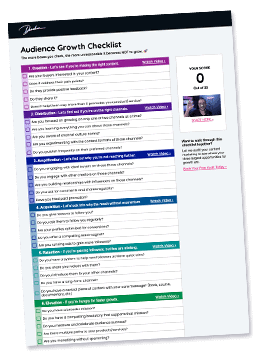Growing an audience is a top priority for most companies, yet many of them continue to struggle with this endeavor. After consulting with dozens of businesses on audience growth, I’ve identified five major reasons why companies have a hard time expanding their reach. In this blog post, we will discuss each of these obstacles in detail and examine why they make it difficult for companies to build their own media, increase subscribers, and garner more attention for their content.
Here are five reasons why they get stuck:
1. Risk Aversion – Content Becomes Too Safe and Forgettable
The first obstacle many companies face is an unwillingness to take risks. They shy away from creating strong, unique points of view and bold content, preferring to play it safe instead. Unfortunately, safe content often translates to boring and forgettable.
Get The Audience Growth Checklist 🚀
Your content deserves an audience. Find out how to get the reach it deserves.
It doesn’t encourage engagement, and people won’t share it with others, leading to stagnated audience growth. Although some companies do possess fresh perspectives and strong content-creation abilities, they still struggle to build an audience due to other factors.
2. Quarterly Conundrum – Too Great An Emphasis On Hitting Quarterly Lead Goals
The most significant obstacle to audience growth is the relentless focus on short-term results. Companies feel immense pressure to generate leads and meet quarterly expectations, with heat coming from the board, CEO, CRO, and sales teams.

Consequently, they prioritize immediate results over long-term audience-building efforts. Audience growth can be slow initially and may not produce immediate results, but it can pay off significantly in the long run. Unfortunately, this shortsighted focus on immediate gains prevents many companies from reaping the benefits of a long-term audience growth strategy.
3. Meatball Sundae – Trying to Get Too Much Out of Individual Channels
This term refers to the common practice of mixing all types of content together in a single channel. For example, a company blog might include top-of-the-funnel content, mid-level content, bottom-of-the-funnel content, press releases, employee celebrations, product demos, and webinars. This “meatball sundae” approach also occurs on company LinkedIn pages, newsletters, and YouTube channels.
The issue with this strategy is that it makes content channels inconsistent and unappealing to potential subscribers. People might visit a channel for a specific piece of content, but they’re unlikely to subscribe and engage consistently due to the lack of coherence. To overcome this obstacle, companies must reevaluate their content organization and delivery strategies.
4. Commodity Content – Having Content Marketers Create Content On Subjects They Don’t Understand
A major problem in content marketing is that the content is created by a bunch of content marketers. As in, people who are experts at making content but not usually in the thing they are making content about.
For example, you could Google “how to run a marathon” and get the tip of a blog post that says “drink water”. It’s an obvious tip that doesn’t add any value. How much water? How frequently? Do I need to drink a lot of water beforehand? Are sports drinks ever appropriate? Of course, I need to drink water. It’s a marathon!

The person who is writing the article though, has never run a marathon and doesn’t know. They might not have ever run more than a mile in their life but they have been tasked with writing a blog post on how to run a marathon. That’s why Google is full of so much commodity content and why SEO marketers spend all their time getting backlinks to prop up bad content.
The content has been outsourced. It lacks the experience and expertise to create useful points of view.
5. They Don’t Count the Costs – Creating a Volume of Original Content Takes Time & Money
Finally, most companies don’t invest enough to create enough quality content. It generally takes ten to one hundred times more effort than they think it will break through the noise. Ten podcast episodes aren’t a good test to see if a podcast is worthwhile. One hundred episodes would be.
You have to put out enough content to test and adapt that content to reach a media/market fit. Without the volume of tests, you’ll never build a channel worth subscribing too. It’s the hardest phase every successful creator has to go through. Businesses also have to pay the price.
Audience growth is a complex and challenging endeavor, with many companies struggling due to a combination of risk aversion, short-term focus, content mishandling, lack of long-term planning, and insufficient content promotion. To overcome these obstacles, companies must reassess their approach to content creation, organization, and distribution, as well as shift their focus toward long-term audience growth strategies.
Building a loyal and engaged audience is not an easy task, but it can be a powerful competitive advantage for those who are willing to tackle these challenges head-on.



